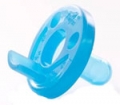 A child dies from tipping furniture, appliances or TVs every two weeks. The statistics for tip-over incidents have grown over the last decade, yet there has been little reform to safety standards. In our new report, Furniture Stability: A review of data and testing, released today in conjunction with Shane’s Foundation, we analyzed data of dresser and chest tip-overs and revealed testing results for 19 furniture units.
A child dies from tipping furniture, appliances or TVs every two weeks. The statistics for tip-over incidents have grown over the last decade, yet there has been little reform to safety standards. In our new report, Furniture Stability: A review of data and testing, released today in conjunction with Shane’s Foundation, we analyzed data of dresser and chest tip-overs and revealed testing results for 19 furniture units.
“Years of work on the voluntary industry standard have resulted in no significant improvements,” said Nancy Cowles, KID executive director. “Our organizations hope this new information will provide the necessary impetus to design, test and sell safer furniture.”
Findings of the data analysis include:
- Two-year-olds are the age group most affected by tip-overs, and are most likely to be killed.
- Head injuries (37%) were the most common category of injury.
- Almost all (98.7%) of head injuries are related to a television tipping over on a child.
In addition to data review, KID put a sample of 19 dressers and chests through stability performance tests. We conducted testing based on the current ASTM standard, followed by new testing protocols we developed in order to simulate real-world scenarios.
Test results include:
- Only nine of the 19 units passed the stability performance tests based on the voluntary ASTM F2057 standard. Only two units passed all our tests.
- The report finds that placing a TV on top of a chest or dresser will not make the unit less stable, but it does increase the likelihood of serious injury or death if it falls.
- Furniture placed on carpeting, which is often found in children’s bedrooms, is less stable than furniture placed on hard floors.
Based on the findings of data and testing, we recommend a two-prong approach.
- Increasing consumer awareness of the danger of furniture tip-overs and knowledge of the actions needed to keep children safe
- Improving furniture stability by strengthening standards, making those standards mandatory and enforceable, and promoting changes in furniture design
The CPSC’s #AnchorIt campaign, which emphasizes the need to attach furniture to a wall with a tip restraint, should be expanded to reach more families. In addition, further research into easier, tool-less tip-over restraints should be encouraged to increase the likelihood that consumers will take action.
“Better designs, stronger standards and enforcement of the standards are needed. We urge furniture manufacturers to look for design solutions to unstable furniture,” added Cowles. “The top performing units in our testing had innovative designs including a wider base, interlocking drawers, or heavier back panels to increase stability.”
“Parents should have peace of mind that furniture in their home is safe, but today’s voluntary safety standards are insufficient, putting children at risk,” commented U.S. Representative Jan Schakowsky. “We need stronger rules and better compliance to prevent tragic accidents from furniture tip-overs. The furniture industry must act to improve safety, and the CPSC and Congress must hold the industry accountable.”
A strong standard to prevent furniture tip-over should include the following:
- All tests should be conducted on a standardized carpet sample to correlate to real-world use more closely.
- The weight specified in testing should better represent the weight of children up to and including age five based on the most recent anthropometric data.
- A test should be added to the standard that would require the furniture to remain stable when all drawers, filled to capacity with clothing, are fully opened.
We urge the ASTM subcommittee on furniture safety to review the report data carefully and to strengthen the F2057 standard in accordance with the findings detailed in this report. At the same time, given the continued rate of injury, the noncompliance with the voluntary standard by manufacturers, and the industry’s resistance to making substantive changes to the standard, KID and Shane’s Foundation urge the CPSC to begin a rulemaking process to make a strengthened standard mandatory and enforceable.
What Can Parents Do With This Information?
Report tip-overs to www.saferproducts.gov
Look for furniture that:
- At least meets the current ASTM F2057-14 standard.
- Includes design innovations (wider base, heavier back board, interlocking drawers) that increase stability.
To read the press release, click here.
To read the full report, click here.
Have an IKEA dresser? Get your refund!



5 Comments